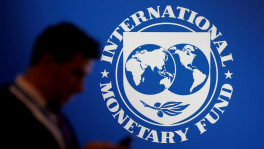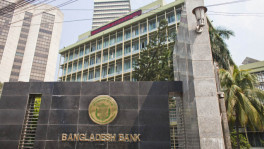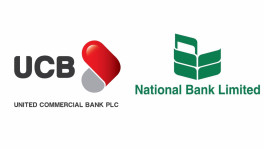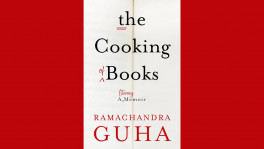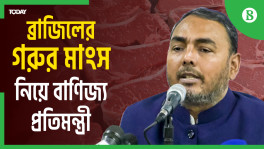A 'prince', East India Company and the history of Bengal’s first bank fraud
In saying that, however, the history of bank scams in this part of the world is fairly long and rather intriguing.

Bank frauds and loan defaults have reached new heights in post-independence Bangladesh. Instances of embezzlement of depositors' money by defaulters in collusion with bank high-ups make headlines every now and then.
In saying that, however, the history of bank scams in this part of the world is fairly long and rather intriguing.
In fact, the very first bank, The Union Bank, established in undivided Bengal during the rule of the East India Company, was plagued by swindles.
The history of the bank – founded by local capitalists, including Rabindranath Tagore's grandfather Dwarkanath Tagore – is a history of deception.
Misappropriation of deposits was not the only menace that the bank faced, but it was also blemished by the fact that the source of wealth of almost all, if not all, of its investors and owners was indigo cultivation – infamous for atrocities on farmers.
Michael Kidron – an economist, Marxist theorist, writer and publisher – has done extensive research on the reference-based history of The Union Bank. He traces the origin of corruption in the bank that started its commercial activities in 1829.
In Kidron's words, "The Union Bank was one of the largest businesses in Calcutta from 1830 to 1847. The joint venture company had hundreds of Indian and European investors. This institution became a symbol of financial power and prestige of the banian class in Calcutta."
He further says the main objectives behind the establishment of the bank were to provide capital for the business class, increase credit, exchange banking, issue banknotes and control the prices of agricultural products. The Union Bank offered equal business opportunities for businessmen from both India and Britain. People of both nations were involved in the management of the bank.
He, however, identifies three major problems concerning The Union Bank – first, the main problem of the bank, like that of other financial institutions in Kolkata, was its over-reliance on the business of the lone export product, indigo; secondly, the then authority, East India Company, did not show interest in playing a regulatory role by providing support to the bank and ensuring proper surveillance; and thirdly, the directors of the bank were preoccupied with their own business and relied on others who could give time to run the bank, but those people were short-sighted and had character flaws.
However, in 1829 when Dwarkanath Tagore and his associates, the partners of Macintosh & Company, launched the new bank, they received a huge response from the local merchant community. At that time the only bank in Calcutta was the semi-government Bank of Bengal that used its capital mainly to buy government bonds.
Even though three private agencies operated somewhat like commercial banks in Kolkata, they were not in a position to carry on the credit business on a large scale as depositors had withdrawn their money at the beginning of the economic crisis of 1830-33.
As a result, there was a demand for new sources of funds among both local and foreign merchant communities. Dwarkanath and other founders of The Union Bank understood this very well.
First loan default
The total capital of the joint venture bank was Rs50 lakh. The total number of shares was 2,000, the price of each was Rs2,500. According to the founding contract, the accounts of the bank would be publicly discussed, there would be regular meetings of the partners and there would be a definite limit on the maximum number of shares owned by an individual. The bank started its operations when Rs12 lakh was raised in capital.
The bank faced a crisis at the outset of its journey. Dwarkanath was the most loyal business associate of the ruling East India Company. Other directors of the bank could not turn down the loan request of Dwarkanath, who earned the epithet of 'Prince' because of his majestic lifestyle and wealth. He personally advocated a loan of Rs6 lakh to John Palmer & Company. This loan was half of the total asset of the bank. As a result, when John Palmer & Co failed to repay the loan in January 1830, The Union Bank was almost on the verge of liquidation.
The bank's then-secretary, William Carr, intervened to prevent the bank from collapsing. He made a cautious decision to take the indigo traders' factory and fixed property (land) as collateral.
Although the bank's declaration did not have a policy of taking fixed assets as collateral in this way, the step gave the bank a power to seize these properties if an indigo agency fails to repay its loan. But William's decision was also inauspicious. As a result, the bank was unable to pay dividends to its shareholders during the commercial crisis of 1830-33. At that time, the share price, which was fixed at Rs2,500, was sold at almost half the price.
However, the situation improved by July 1833 and the bank paid an 8% dividend to its shareholders.
There were more problems. In the late 1830s, the bank's board of directors made three wrong decisions after being persuaded by Dwarkanath. The first decision was to increase the capital of the bank from Rs15 lakh to Rs1 crore. Secondly, they decided to engage in a large-scale bill of exchange (hundi) business. And the third decision was to provide large loans to indigo traders.
In those days, hundi business was legal. However, due to not having enough capital to do this business profitably, the bank fell into a liquidity crisis. The bank's assets became almost exhausted as the loan given out to indigo businesses continued to turn bad.
Dwarkanath himself was involved in indigo cultivation. He was also a big patron, financier of these indigo traders.
Kidron notes that from the outset Dwarkanath intended to involve The Union Bank in the sale and purchase of hundi bills for import and export of agricultural products, including indigo.
"At that time, the agency houses in Calcutta and the East India Company were jointly controlling the business. Dwarkanath was a representative of the indigo factory owners. New competitors in buying and selling of bills would actually benefit the indigo factories, and that is why Dwarkanath made this decision. In fact, his main goal was to create this facility rather than to sell bills."
However, the bank's partners involved in the bill business began to strongly oppose the decision.
Realizing that the situation was not in their favour, Dwarkanath and his associates adopted a new strategy. They did not directly propose to enter the hundi business, but focused on increasing the bank's capital. As a result, even those who opposed the hundi business were compelled to decide in its favour eventually.
Thus, the capital of the bank increased from Rs15 lakh to Rs21.60 lakh by 1836. The capital increased to Rs32 lakh in 1837, Rs80 lakh in 1838, and Rs1 crore by 1839, says Kindron.
Nepotism and undue power practice
Dwarkanath had absolute control over the bank. As a result, since 1834, representatives from only six agency houses – Carr, Tagore & Company, Cockrell & Company, Gilmore & Company, Hamilton & Company, Ferguson Brothers and William Strom – were appointed as directors of the bank.
At the time when he had maximum control over the bank, Dwarkanath owned 700 out of its 2,500 shares.
Thus Dwarkanath kept the policy of the bank under his complete control till 1844.
Dwarkanath also appointed people of his choice to important positions in the bank through nepotism. Among them, the cases of accountant AH Sim and bank secretary George James Gordon were the most important. Sim forged accounts while Gordon used his position to lend money to companies that defaulted on loans.
Dwarkanath came forward to protect both the corrupt officials. Although the bank lost a total of Rs5,99,000 because of Gordon and Sim, he prevented the authorities from taking appropriate punitive action against them.
This control was not only due to his having maximum share ownership but also to the fact that he retained his friends, relatives and businessmen who depended on him by giving ownership of the bank's shares. The biggest example of Dwarkanath's control was an incident relating to a bureaucrat named AH Sim.
Sim was an accountant. He was fired in 1838 for minor misconduct. He was later reinstated by a vote of shareholders controlled by Dwarkanath. Then in May 1839, one of the Indian clerks told Dwarkanath that Sim had embezzled Rs1,20,600. Upon learning of the incident, Dwarkanath, in consultation with other influential directors William Carr, Longville Clark, and Chairman James Cullen, promised to pay the money himself, on condition of anonymity.
However, the matter was not kept secret and Dwarkanath paid it out of his own pocket to allay the panic of the depositors.
In 1840, Dwarkanath appointed his friend George James Gordon as bank secretary, replacing James Young. Gordon came to India empty-handed after losing everything in the 1830-33 London stock market collapse. He needed a high-paying job to survive the financial loss. Dwarkanath gave him a job, called another board meeting and increased his salary from Rs1600 to Rs2500. Here, too, the opposing partners lost by a large margin in the face of Dwarkanath's influence.
Meanwhile, at a board meeting in 1840, a special loan classification was introduced for the purpose of giving unlimited loans to indigo cultivators. Indigo cultivation agencies could easily take out loans according to their needs and had the privilege to repay them at their convenience. This loan scheme was a breach of The Union Bank agreement. The agreement had a provision for confiscating the collateral if borrowers failed to pay installment for four months.
But to avoid that rule, indigo growers were given the opportunity to renew their loans every three months by paying interest.
During the commercial crisis of 1842, when several large indigo growers who had taken out loans from The Union Bank in this way went bankrupt, the bank incurred huge losses. The shareholders called the company secretary to explain the reasons for the loss. Secretary Gordon completely denied the loss. He had been making this false statement for over a year.
However, in 1843, the information of loss was leaked. At that time, a committee of the bank alleged that the bank lost the entire amount of Rs4,79,663, given out in loans to Gilmore & Company, due to either collaboration or negligence of James Gordon.
In 1840, Gilmore borrowed Rs2,71,095 from The Union Bank to buy a coal mine. But as the company failed to acquire the coal mine, its ownership changed.
Gordon lent the rest of the lost money to Gilmore & Company for the purposes of indigo, copper and sugar businesses. At that time, the bank did not only fake the prices of these products but also allowed the borrowers to get the goods released from the warehouse even after defaulting on loans.
The tragic end
By 1845, Dwarkanath Tagore sold all the shares of The Union Bank under his control. He was also raising enough money for a trip to England for a second time.
He made the decision after realising that the bank was sinking due to the excesses he and his associates committed. By that time his health had also deteriorated. Gradually, he sold his commercial assets and started buying zamindaris. He arranged for the distribution of these zamindaris among his sons.
He took his youngest son Nagendranath, nephew Nabin Chandra, personal physician, secretary, chef and three servants with him on his way to Britain. His physical condition became increasingly fragile due to the emotional impact of the collapse of his businesses. He died in London on 1 August 1848 at the age of 51 and was laid to rest at the Kensal Green Cemetery in London.
Meanwhile, The Union Bank also went broke by 1848 by giving loans to loss-making businesses. In this way, the first private bank in Bengal came to a tragic end.


 Keep updated, follow The Business Standard's Google news channel
Keep updated, follow The Business Standard's Google news channel
